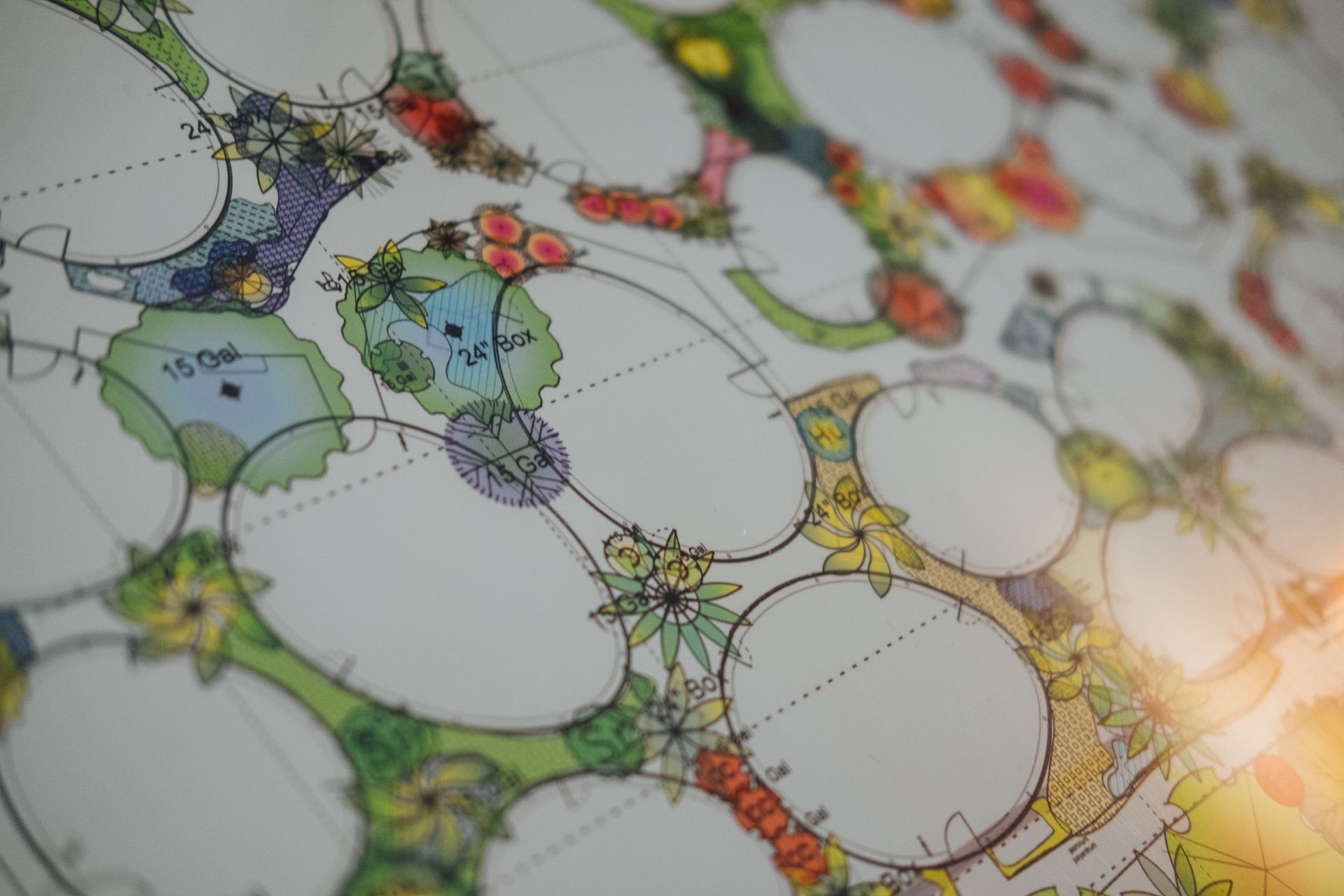How to Design A Garden in 10 Steps
Telephone:
0115-824-4801
What You Must Do Before Designing Your Garden
Before designing a garden, one should consider their needs and wants as well as the climate and soil conditions of the area. Researching plants that are suitable for the conditions is essential for success. Additionally, it can be helpful to draw a plan or sketch out ideas of how you want the garden to look. Lastly, ensure that you have enough resources such as materials and tools before starting your project. This will help prevent any frustrating delays once you begin gardening. Taking these preliminary steps is essential before diving into designing a beautiful outdoor oasis.
Once these things are taken care of, start bringing your vision to life by choosing colours and textures for different elements in the garden. Think about what kind of plants you would like to use in your garden and where you can place them. Consider the environment of your garden and make sure to choose plants that are native to that area or hardy enough to survive in the climate. Incorporating a variety of blooming and evergreen plants will help create an interesting design as well as add depth and texture.
It can also be helpful to divide your garden into separate areas, such as a seating area or dining space, so you know how much space you’re working with. This will give you a better idea for how many plants to use in each area as well as selecting furniture pieces that fit within the designated spaces. If there is extra room, adding water features like fountains or ponds can be a great way to add a unique element to your garden.
Finally, when starting to design, it’s important to consider the sun exposure that each space or area receives throughout the day. Taking into account how much direct sunlight and shade different spots receive will help you better determine which plants to use in each area of your garden. This will also inform any potential DIY projects you may want to undertake such as installing a trellis, building raised beds, or creating planters—all of which can be great additions to an outdoor oasis!
Your 10 Step Garden Design Plan
Creating a beautiful garden is an enjoyable and rewarding task. With the right plan and these 10 steps, you can design a stunning outdoor paradise that will be the envy of your neighbourhood. Begin by researching different styles like modern, traditional, or tropical gardens to determine which best suits your style and outdoor space.
Once you have chosen a theme, draw out a plan on paper to figure out where each element should go in relation to one another. Then start preparing the soil by removing existing plants and debris and amending it with compost or other organic material as needed. After planting flowers, trees, and shrubs according to your design, add details such as mulch beds, stepping stones for pathways, decorative rocks for accents, bird baths for wildlife, and outdoor furniture for relaxing. Finally, remember to water regularly and provide adequate sunlight for optimal growth. By following these steps, you can create beautiful gardens that bring a sense of peace and pleasure to your home.
And don't forget the finishing touches! An outdoor lighting system not only adds ambiance but also helps with nighttime visibility so you can enjoy your garden late into the evening. You may also want to consider adding a fountain or pond for added interest—a simple water feature can be just what your garden needs to make it complete. No matter which elements you choose, keep in mind that gardens are meant to be enjoyed, so have fun while designing! With some planning and creativity, you'll soon have a dream garden of your own.
Step 1: Identify Your Needs and Wants – Start by assessing what you hope to achieve with your garden design. Are you looking for a peaceful spot for relaxation, an outdoor living space for entertaining, or a low-maintenance area that’s easy to care for? Having a clear idea of your goal will make it easier to choose plants, furniture, and other elements that meet your needs.
Step 2: Establish Your Budget – Knowing how much money you have available for the project is essential in helping you stay within your means. Consider how much time and energy you can dedicate to maintaining the garden—keeping these costs in mind as well as any upfront costs of materials and labour.
Step 3: Measure the Space – Make sure to take accurate measurements of your space so that you can plan accordingly. Pay attention to factors such as sun exposure, shade, wind, soil type, and other conditions that could affect your design plans.
Step 4: Select Plants – Choose plants based on their size, color, texture, and growing requirements. Consider creating separate areas for flowers, vegetables/herbs, shrubs/trees, and grasses/ground cover.
Step 5: Choose Patio Furniture – Decide what type of seating is desired—loungers or dining tables and chairs. And don’t forget about umbrellas or other shading options.
Step 6: Incorporate Garden Accessories – Add charm and personality to your garden with planters, benches, birdbaths, fountains, trellises, and other decorative elements.
Step 7: Create Focal Points – Strategically placed features like sculptures and water features will draw the eye and make the garden visually appealing.
Step 8: Consider Drainage – Be sure to account for where rainwater will go in order to ensure that plants do not suffer from over saturation or standing water. Install drainage systems if necessary.
Step 9: Prepare Soil – Before planting anything in the ground, be sure to prepare the soil by adding nutrients such as compost or manure. This will help promote healthy growth for the plants and flowers.
Step 10: Plant – The final step is to add your chosen plants and flowers to create a lush, vibrant garden that will be enjoyed by all. Be sure to group similar plants together as they require similar care, and also consider their water needs when deciding where to place them.
Once you have finished these steps, it's time to sit back and enjoy your beautiful garden! With a little planning and creativity, you can transform any space into an outdoor oasis. Don't forget to maintain your garden with regular watering and pruning, so that it stays looking its best. Have fun designing!
What to avoid when designing a garden
When designing a garden, there are some elements that should be avoided. One of the most common mistakes is overcrowding plants. Too many plants in too small of a space can lead to overcrowding and competition for resources like light, water, and nutrients. Furthermore, it can also create an environment where pests and diseases can thrive.
In addition to overcrowding, another mistake when designing a garden is not considering the different growing conditions of each plant. Plants have different requirements for soil types and moisture levels as well as what kind of sunlight they need to thrive. Not accounting for these differences could mean that some plants will die or fail to thrive while others may flourish.
Finally, one more thing to avoid when designing a garden is over-watering. Too much water can drown a plant’s roots and cause it to die due to lack of oxygen. Additionally, overwatering can lead to root rot caused by fungal disease. It is important to know the water needs of each type of plant in your garden and make sure they are not getting too much or too little.
Other points to consider
It's important to avoid certain things when designing a garden. Here are some tips on what to avoid:
Over planting: Don't overcrowd your garden with too many plants, as this will make it difficult for them to grow and compete for nutrients.
Poor soil preparation: Make sure you prepare the soil before planting by removing weeds, tilling and adding organic matter. This will help ensure that plants get the best possible start when growing in your garden.
Too much sun: Sun can be beneficial for some plants, but too much can damage or even kill them. Consider selecting plants that can tolerate or even thrive in partial shade to reduce risk of plant damage from too much sunlight exposure.
Not accounting for pests: Certain plants may be inviting to pests such as deer, rabbits, and rodents. Consider planting species that are less likely to attract these animals and use deterrents if necessary.
Not considering water needs: Different plants have different water requirements. Make sure you know how much water each plant in your garden needs in order to keep them healthy and hydrated.
Neglecting maintenance: A garden requires regular maintenance in order to thrive, such as deadheading flowers, weeding, pruning, fertilising, and mulching. Without proper upkeep, the quality of your garden will suffer.
Poor landscape design: If your landscape is not designed correctly it can look disjointed and unbalanced. Choose plants that complement each other in terms of size, shape, and color. Make sure to space them out correctly so they have enough room to grow and not crowd each other out.
Not using the right soil: Different types of soil are better suited for certain types of plants. Make sure you use quality soil with appropriate drainage and nutrients for your garden’s needs.
Ignoring climate conditions: Consider the temperature, humidity, sun exposure, rainfall amounts, and wind levels in your area when selecting plants for your garden. Pick varieties that are well adapted to those conditions in order to ensure success.
Poorly positioned paths: Paths should be designed in consideration of how you move through your garden. They should connect different areas in ways that make sense, taking into account the shape of the beds and any existing trees or hardscaping elements.
Not using edging materials: Edging materials are used to define borders between planting beds, walkways, and other garden features like patios and water features. Creating clearly defined edges is important for both aesthetic and practical purposes.
Is it best to hire a garden designer
When hiring a garden designer there are certain things to consider. Firstly, it's important to look at the credentials of any potential design company before making your decision. Are they experienced in designing outdoor spaces? Have they worked on projects similar to what you have in mind? It's also helpful to ask for photos and references from past clients so that you can get an idea of their workmanship.
It is also important to consider the budget when looking into hiring a garden designer. While it may be tempting to DIY your outdoor space, engaging a professional will ensure that the job gets done correctly and efficiently - saving you time, hassle, and money in the long run.
A good landscape garden designer should be able to provide you with an upfront cost estimate so that you can determine whether their services are within your budget.
You should also take the time to learn more about the garden designer's style and philosophy when it comes to designing outdoor spaces. Do they focus on sustainability or prefer a traditional look? By learning more about their style, you will be able to get a better sense of how your vision for the space might be realised.
Finally, when choosing a garden designer, make sure that you feel comfortable with them. You'll likely be working together very closely in order to create the desired outcome and it's important that you feel like your ideas and opinions are respected and taken into consideration throughout the process. Make sure that there is good communication between both parties from start to finish, and that you feel confident in the designer's abilities to deliver the result you desire. With careful planning and the right garden designer, you can create an outdoor space that is both beautiful and environmentally sustainable. A great garden design will not only add value to your home but also provide you with a place of relaxation and enjoyment for years to come.
The decision of whether or not to hire a garden designer should be based on your individual needs and preferences. Evaluate your current landscape, consider your budget, think about what kind of look you want for your outdoor space, and take into account any other relevant factors before making your choice. Doing so will ensure that you make the best decision possible when it comes to designing your dream outdoor area.



